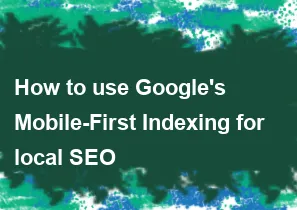How to use Google's Mobile-First Indexing for local SEO

Mobile-First Indexing is a shift in how Google indexes and ranks websites. Google primarily uses the mobile version of a site's content for indexing and ranking, which means that the mobile version of your website becomes the baseline for how Google determines its rankings. This is especially important for local SEO, as many users access local businesses through mobile devices. Here are some tips on how to leverage Mobile-First Indexing for local SEO:
Mobile-Friendly Design:
- Ensure that your website is mobile-friendly. Use responsive design to provide a seamless experience across various screen sizes.
- Test your site's mobile-friendliness using tools like Google's Mobile-Friendly Test.
Local Business Information:
- Ensure that your business's name, address, and phone number (NAP) are consistent across all online platforms, including your website, Google My Business (GMB), local directories, and social media profiles.
- Optimize your Google My Business listing with accurate and up-to-date information.
Page Speed:
- Optimize your website's loading speed for mobile devices. Faster-loading pages improve user experience and can positively impact your search rankings.
- Use tools like Google PageSpeed Insights to identify and fix speed-related issues.
Mobile-Optimized Content:
- Ensure that the content on your website is easily readable and accessible on mobile devices. Avoid using Flash and other technologies that may not be supported on mobile browsers.
- Keep your content concise, relevant, and easy to navigate.
Local Keywords:
- Incorporate local keywords naturally into your mobile content. This includes location-specific terms that potential customers might use when searching for businesses in your area.
- Think about the terms people might use on mobile devices when conducting voice searches.
Local Schema Markup:
- Implement local schema markup to provide search engines with additional information about your business, such as your address, phone number, business hours, and more.
- This helps search engines better understand your content and improves the chances of showing rich snippets in search results.
Mobile Sitemaps:
- Create and submit a mobile sitemap to Google Search Console. This helps Google discover and index your mobile content more efficiently.
- Ensure that your mobile and desktop versions have consistent URLs for corresponding pages.
User Experience:
- Prioritize user experience on mobile devices. This includes easy navigation, clear calls-to-action, and a seamless experience from landing to conversion.
- Optimize your mobile site's design for touch interactions.
Local Reviews and Ratings:
- Encourage customers to leave reviews on your Google My Business profile. Positive reviews can influence local search rankings.
- Respond to reviews, both positive and negative, to show engagement and build trust with potential customers.
By focusing on these aspects, you can enhance your local SEO strategy, taking advantage of Google's Mobile-First Indexing to improve your website's visibility in mobile search results. Regularly monitor your website's performance and adapt your strategy based on changes in search engine algorithms and user behavior.
-
Popular Post
- How to optimize for Google's About This Result feature for local businesses
- How to implement multi-language support in an Express.js application
- How to handle and optimize for changes in mobile search behavior
- How to handle CORS in a Node.js application
- How to use Vue.js with a UI framework (e.g., Vuetify, Element UI)
- How to configure Laravel Telescope for monitoring and profiling API requests
- How to create a command-line tool using the Commander.js library in Node.js
- How to implement code splitting in a React.js application
- How to use the AWS SDK for Node.js to interact with various AWS services
- How to use the Node.js Stream API for efficient data processing
- How to implement a cookie parser middleware in Node.js
- How to implement WebSockets for real-time communication in React
-
Latest Post
- How to implement a dynamic form with dynamic field styling based on user input in Next.js
- How to create a custom hook for handling user interactions with the browser's device motion in Next.js
- How to create a custom hook for handling user interactions with the browser's battery status in Next.js
- How to implement a dynamic form with dynamic field visibility based on user input in Next.js
- How to implement a dynamic form with real-time collaboration features in Next.js
- How to create a custom hook for handling user interactions with the browser's media devices in Next.js
- How to use the useSWRInfinite hook for paginating data with a custom loading indicator in Next.js
- How to create a custom hook for handling user interactions with the browser's network status in Next.js
- How to create a custom hook for handling user interactions with the browser's location in Next.js
- How to implement a dynamic form with multi-language support in Next.js
- How to create a custom hook for handling user interactions with the browser's ambient light sensor in Next.js
- How to use the useHover hook for creating interactive image zoom effects in Next.js